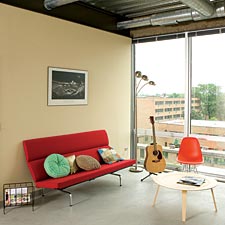 |
| A dorm room at Loft-Right |
Parents dropping off their kids at college used to pull up in front of an all-too-familiar monstrosity: the undergraduate dorm. At best, the rooms were humble and dingy, with an industrial ambiance and a bathroom at the end of a very long hall. “Twenty years ago, student housing was like a motel,” says Robert Bronstein, the president of Scion Group, a local real-estate firm that believes today’s college students want to live like well-paid professionals. “We’re trying something different. We’re trying to offer people the W Hotel.”
Bronstein’s company has carved out a niche that, a few decades ago, was unforeseen in urban real estate-the luxury dorm. This fall, about 600 DePaul students will move into the $75-million Loft-Right, a building that could easily double as a pricey Lincoln Park condo. The sleek glass-and-steel structure dominates almost a full block of DePaul’s campus along Fullerton
Avenue. Rooms boast exposed ceilings, ten-foot windows, granite counters, stainless-steel appliances, and Herman Miller furniture. Gone are the days
of bunk beds; units house four students-each of whom gets a private bedroom. Parent-pleasing perks include 24-hour security, parking, and a doorman.
Of course, so much luxury doesn’t come cheap. To live at Loft-Right (a building neither owned nor operated by DePaul), students each pay an average rent of about $1,045 a month, including utilities; university housing typically costs about 10 percent less, a spokeswoman says, but comparisons are tricky because nothing on campus comes close. Off-campus rentals can be less expensive, but without the amenities. “Parents appreciate a building with a doorman and 24-hour security,” says Bronstein.
 |
| Robert Bronstein |
At 32, the savvy businessman is only a decade beyond his own college days at the University of Michigan, where he studied economics and lived in a “spartan” freshman dorm. He came to Chicago to work for Equis Corp., a large corporate real-estate firm, but left in 1999 to launch Scion with his brother, Eric. Less than a year into it, the pair took a gamble on a tantalizing opportunity: a growing number of commuter colleges were looking to change course and provide housing to their students. “With every project we did, we were surprised by how much people wanted and how much they were willing to pay,”Bronstein says. “With each project, we were like, ‘Man, we didn’t push the envelope far enough.'”The duo still hasn’t overestimated the market: at Loft-Right, Scion’s most ambitious project, most of the 160 units were rented by summer.
For years, the real-estate industry ignored the college market, figuring that the provision of rooms for college students was a bare-bones task with little financial upside. Now some real-estate prospectors see student housing as the next red-hot market, right up there with senior homes for aging baby boomers, says Michael Zaransky, CEO of Prime Property Investors in Northbrook and author of the new book Profit by Investing in Student Housing. The reason? Boomer parents who are enjoying unprecedented prosperity and raising children have money to spend. “There’s an expectation that they should live in a more luxurious property when they’re in college,”says Zaransky.
Still, hot market or not, college students will remain, well, college students. During a recent visit to Loft-Right, Bronstein spent several minutes
trying to find a small sofa that someone had pilfered from a student lounge and, more than likely, claimed for a student room. “We buy durable stuff,” Bronstein said, unfazed, “and we have substantial allowances for repair and refurbishment.” The surroundings may be more luxurious, but college behavior, it seems, is one thing that hasn’t changed with time.
Photography: Peter Wynn Thompson


